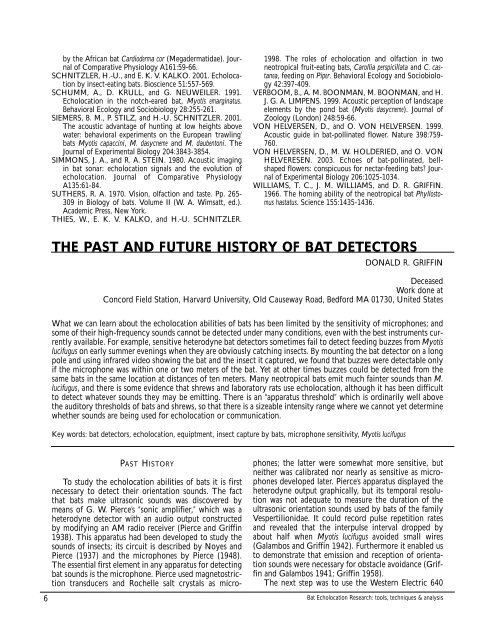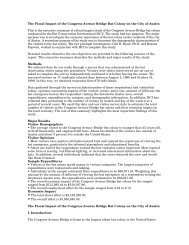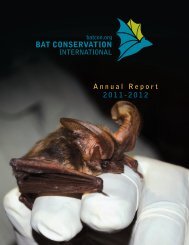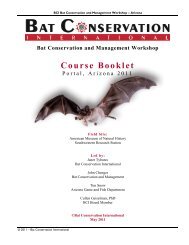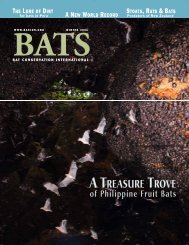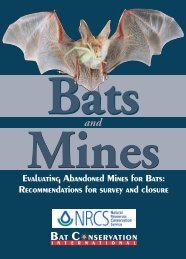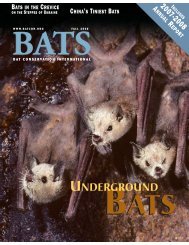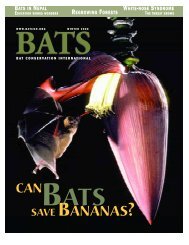Bat Echolocation Researc h - Bat Conservation International
Bat Echolocation Researc h - Bat Conservation International
Bat Echolocation Researc h - Bat Conservation International
Create successful ePaper yourself
Turn your PDF publications into a flip-book with our unique Google optimized e-Paper software.
y the African bat Cardioderma cor (Megadermatidae). Journal<br />
of Comparative Physiology A161:59-66.<br />
SCHNITZLER, H.-U., and E. K. V. KALKO. 2001. <strong>Echolocation</strong><br />
by insect-eating bats. Bioscience 51:557-569.<br />
SCHUMM, A., D. KRULL, and G. NEUWEILER. 1991.<br />
<strong>Echolocation</strong> in the notch-eared bat, Myotis emarginatus.<br />
Behavioral Ecology and Sociobiology 28:255-261.<br />
SIEMERS, B. M., P. STILZ, and H.-U. SCHNITZLER. 2001.<br />
The acoustic advantage of hunting at low heights above<br />
water: behavioral experiments on the European ‘trawling’<br />
bats Myotis capaccini, M. dasycneme and M. daubentoni. The<br />
Journal of Experimental Biology 204:3843-3854.<br />
SIMMONS, J. A., and R. A. STEIN. 1980. Acoustic imaging<br />
in bat sonar: echolocation signals and the evolution of<br />
echolocation. Journal of Comparative Physiology<br />
A135:61-84.<br />
SUTHERS, R. A. 1970. Vision, olfaction and taste. Pp. 265-<br />
309 in Biology of bats. Volume II (W. A. Wimsatt, ed.).<br />
Academic Press, New York.<br />
THIES, W., E. K. V. KALKO, and H.-U. SCHNITZLER.<br />
1998. The roles of echolocation and olfaction in two<br />
neotropical fruit-eating bats, Carollia perspicillata and C. castanea,<br />
feeding on Piper. Behavioral Ecology and Sociobiology<br />
42:397-409.<br />
VERBOOM, B., A. M. BOONMAN, M. BOONMAN, and H.<br />
J. G. A. LIMPENS. 1999. Acoustic perception of landscape<br />
elements by the pond bat (Myotis dasycneme). Journal of<br />
Zoology (London) 248:59-66.<br />
VON HELVERSEN, D., and O. VON HELVERSEN. 1999.<br />
Acoustic guide in bat-pollinated flower. Nature 398:759-<br />
760.<br />
VON HELVERSEN, D., M. W. HOLDERIED, and O. VON<br />
HELVERESEN. 2003. Echoes of bat-pollinated, bellshaped<br />
flowers: conspicuous for nectar-feeding bats? Journal<br />
of Experimental Biology 206:1025-1034.<br />
WILLIAMS, T. C., J. M. WILLIAMS, and D. R. GRIFFIN.<br />
1966. The homing ability of the neotropical bat Phyllostomus<br />
hastatus. Science 155:1435-1436.<br />
THE PAST AND FUTURE HISTORY OF BAT DETECTORS<br />
DONALD R. GRIFFIN<br />
Deceased<br />
Work done at<br />
Concord Field Station, Harvard University, Old Causeway Road, Bedford MA 01730, United States<br />
What we can learn about the echolocation abilities of bats has been limited by the sensitivity of microphones; and<br />
some of their high-frequency sounds cannot be detected under many conditions, even with the best instruments currently<br />
available. For example, sensitive heterodyne bat detectors sometimes fail to detect feeding buzzes from Myotis<br />
lucifugus on early summer evenings when they are obviously catching insects. By mounting the bat detector on a long<br />
pole and using infrared video showing the bat and the insect it captured, we found that buzzes were detectable only<br />
if the microphone was within one or two meters of the bat. Yet at other times buzzes could be detected from the<br />
same bats in the same location at distances of ten meters. Many neotropical bats emit much fainter sounds than M.<br />
lucifugus, and there is some evidence that shrews and laboratory rats use echolocation, although it has been difficult<br />
to detect whatever sounds they may be emitting. There is an “apparatus threshold” which is ordinarily well above<br />
the auditory thresholds of bats and shrews, so that there is a sizeable intensity range where we cannot yet determine<br />
whether sounds are being used for echolocation or communication.<br />
Key words: bat detectors, echolocation, equiptment, insect capture by bats, microphone sensitivity, Myotis lucifugus<br />
6<br />
PAST HISTORY<br />
To study the echolocation abilities of bats it is first<br />
necessary to detect their orientation sounds. The fact<br />
that bats make ultrasonic sounds was discovered by<br />
means of G. W. Pierce’s “sonic amplifier,” which was a<br />
heterodyne detector with an audio output constructed<br />
by modifying an AM radio receiver (Pierce and Griffin<br />
1938). This apparatus had been developed to study the<br />
sounds of insects; its circuit is described by Noyes and<br />
Pierce (1937) and the microphones by Pierce (1948).<br />
The essential first element in any apparatus for detecting<br />
bat sounds is the microphone. Pierce used magnetostriction<br />
transducers and Rochelle salt crystals as microphones;<br />
the latter were somewhat more sensitive, but<br />
neither was calibrated nor nearly as sensitive as microphones<br />
developed later. Pierce’s apparatus displayed the<br />
heterodyne output graphically, but its temporal resolution<br />
was not adequate to measure the duration of the<br />
ultrasonic orientation sounds used by bats of the family<br />
Vespertilionidae. It could record pulse repetition rates<br />
and revealed that the interpulse interval dropped by<br />
about half when Myotis lucifugus avoided small wires<br />
(Galambos and Griffin 1942). Furthermore it enabled us<br />
to demonstrate that emission and reception of orientation<br />
sounds were necessary for obstacle avoidance (Griffin<br />
and Galambos 1941; Griffin 1958).<br />
The next step was to use the Western Electric 640<br />
<strong>Bat</strong> <strong>Echolocation</strong> <strong>Researc</strong>h: tools, techniques & analysis


